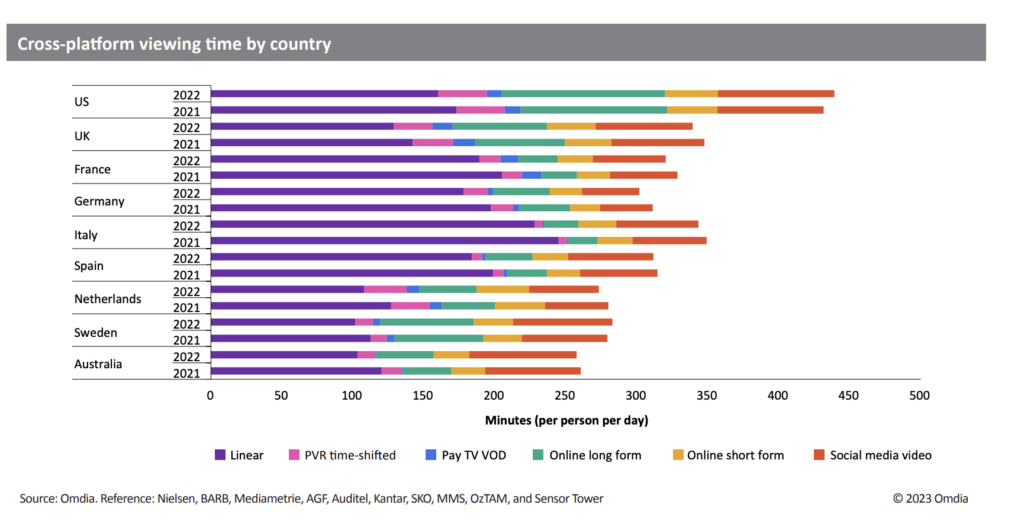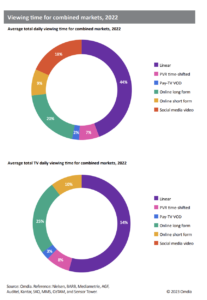
After more than 40 years of operation, DTVE is closing its doors and our website will no longer be updated daily. Thank you for all of your support.
DTVE Data Weekly: The rise of nonlinear and online viewing in the US and UK
 Omdia has seen two key trends that shaped cross-platform viewing time in 2022: a decline in linear viewing and the ascendance of nonlinear platforms such as online long form and social media video viewing. Despite these overarching themes, the state of play between certain markets remains resolutely different. Traditional linear TV viewing, for example, remains the dominant form of viewing in Australia and across most of Europe, including France, Germany, Italy, and Spain. Omdia believes those markets are set to remain that way for several years.
Omdia has seen two key trends that shaped cross-platform viewing time in 2022: a decline in linear viewing and the ascendance of nonlinear platforms such as online long form and social media video viewing. Despite these overarching themes, the state of play between certain markets remains resolutely different. Traditional linear TV viewing, for example, remains the dominant form of viewing in Australia and across most of Europe, including France, Germany, Italy, and Spain. Omdia believes those markets are set to remain that way for several years.
However, in the US, UK, Sweden, and the Netherlands, linear has fallen below the 50% share threshold, with nonlinear viewing now the dominant viewing method. When combining all nine of the analyzed markets, we see a blend of how these varying trends collide. Average daily total viewing time stood at 373 minutes per person per day in 2022, with no increase in viewing from the previous year. However, if social media is excluded, average daily television viewing time fell by 6 minutes to 305 minutes. This indicates that although nonlinear TV and online viewing are on the rise, the added effects of cord-cutting and the increase in social media viewing continue to drive a decline in linear TV viewing times.
Linear TV viewing time decreased in all markets in 2022—the continual shift toward on-demand and social media viewing drove this fall. In overall minutes, Germany (-19.3 minutes) and the Netherlands (-19 minutes) saw the largest declines in linear viewing—a significant contrast to the previous year when Italy and Spain recorded the largest decreases. Online long form was a key area of growth across all markets, increasing on average to 75 minutes, while online short form rose by 5.8% (2 minutes) to 32 minutes.
Time-shifted viewing (TSV) also grew during the year, with growth up by 1.1% to reach 24.3 minutes. On the other hand, pay-TV video on demand (VOD) was the only nonlinear platform to experience a decline in viewing in 2022, a fate tied to the ongoing decline in pay-TV subscriptions across the respective regions. Viewing video content via social media platforms also grew substantially in 2022, with viewing up by 5.8 minutes, reaching an average of 68 minutes per person per day across the nine markets analyzed. TikTok was the leading platform for social media video viewing time in 2022, overtaking Facebook for the first time as the latter’s global monthly active users (MAU) continued to decrease. In total, average viewing for TikTok reached 23.6 minutes in 2022, a 4.5-minute increase from the previous year.
US Linear viewing
Total TV viewing time in the US increased by just 0.1% to reach 357.1 minutes per person per day in 2022, with linear’s decline effectively negating growth in other areas. Linear viewing was down for another consecutive year in 2022, decreasing by 7.3% (-12.7 minutes) in 2022. The acceleration of cord-cutting in the US pay-TV market continued to play a central role in driving this decline as the pay-TV market lost 6.3m customers during the year. Linear TV’s market share also moved firmly below nonlinear’s in 2022, falling to 45%, reflecting the US’s position as the most technologically advanced country for streaming services.
However, the dynamics of the linear experience are still seen when linear and time-shifted viewing are combined: combined methods hold a 54.5% market share. Online long form consumption continues to have a strong presence in the nonlinear market, with 115 viewing minutes per person per day, up 11.2% from last year. Growth in OTT video subscriptions largely underpins this level of consumption; the OTT market grew by 67m new customers to reach 437 million customers by the end of the year, more than seven times the number of pay-TV subscriptions. Omdia forecasts additional growth of 32.6% by the end of 2028, meaning the online total of 615m will nearly be 10 times that of pay TV.
 Netflix remains the most popular service in the US, with 66.8m subscriptions. However, the company experienced its first year of decline in 2022, losing 738,000 customers. Market growth, therefore, was led by many of the country’s top players, including Apple TV+, Peacock, and Paramount+, which all registered subscription growth of over 50%. Paramount+ has done particularly well, reaching 35.2m subscriptions in the US by the end of 2022, outperforming HBO Max through strong strategic partnerships.
Netflix remains the most popular service in the US, with 66.8m subscriptions. However, the company experienced its first year of decline in 2022, losing 738,000 customers. Market growth, therefore, was led by many of the country’s top players, including Apple TV+, Peacock, and Paramount+, which all registered subscription growth of over 50%. Paramount+ has done particularly well, reaching 35.2m subscriptions in the US by the end of 2022, outperforming HBO Max through strong strategic partnerships.
Online short form grew relatively steadily in 2022, with a 5% increase to 37 minutes. Growth has been aided somewhat by YouTube Shorts, which allow users to upload long-form videos and Shorts (capped at 60 seconds in length). In the coming year, YouTube is set to introduce new smartphone controls and interactivity features for connected TVs, allowing users to comment and share content, driving engagement and usage further. UK: Social media viewing is 2 minutes ahead of online long-form viewing Full-year data for 2022 indicates that the pandemic boost in viewing times will ultimately be a temporary phenomenon. After posting a 6% decline in 2021, UK cross-platform viewing time fell by a further 4% in 2022 to reach 271.1 minutes per person per day. The drop in linear TV viewing was the most significant feature of this decline, with viewing down by more than 13 minutes, driven by a growing number of consumers preferring to stream or download content rather than watch live, linear broadcasts. Linear viewing took 48% of total viewing. However, when time-shifted PVR viewing is included, linear remains the most popular way to watch TV in the UK, holding a combined viewing share of 57.6%.
While all traditional TV formats experienced a viewing decline in 2022, the two online categories grew. Online long-form viewing increased by 3.1 minutes to exceed 66 minutes per person per day. Online short-form viewing, meanwhile, increased by 2 minutes during the year to reach 34.3 minutes per person per day. Increasing penetration of superfast/ ultrafast broadband is facilitating the ongoing growth in online short-form viewing. SVOD services, led by Netflix and Amazon Prime Video, were behind much of this growth in long-form viewing time.
Although the global economic malaise has encouraged some players to become more cautious in their content spending plans, original programming is still the vital ingredient that drives customer subscription numbers (and viewing time), and SVOD providers continue to boost the volume of originals and exclusives available on their services. Like linear TV viewing, pay-TV VOD also registered a downturn in viewing in 2022, decreasing by 8% to 14.3 minutes. This decline in viewing time was largely driven by pay-TV leader Sky, which is under pressure from online video alternatives. Notwithstanding this, pay-TV VOD’s overall position in the UK is better than in many other similar markets, assisted by Sky UK’s heavy investment in its own local content, Sky Originals, which has helped propel it to the position of one of the largest pay-TV operators in Europe.
Rob Moyser is an Omdia senior analyst, TV & Online Video.


